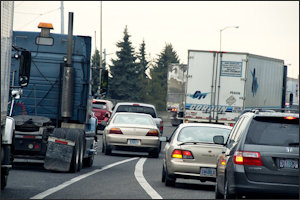
Want to suck the soul out of your community and destroy its vitality? Build more stroads. Photo credit: Strong Towns.
I have a meeting tomorrow with Augie Wallmeyer, author of “The Extremes of Virginia,” a book that highlights the perilous social and economic condition of rural/small town Virginia. In anticipation of the conversation, I have been reflecting upon what it takes to stabilize rural counties whose economies have been devastated by the decline of coal, tobacco, furniture, textiles and apparel. With all the challenges they face, which Wallmeyer has described in copious detail, can these hard-hit communities reinvent themselves for the 21st century?
There are at least two parts to this question. One, which tends to get the most attention, is economic development: how to stimulate jobs and investment. A second, which gets overlooked here in Virginia, is how to maintain essential government services in a jurisdiction with an eroding population and fragile economy. The latter task is as essential as the former. If counties and small cities can’t maintain basic services, how can they hope to compete for people and jobs?
In the course of these ruminations, I encountered a recent blog post by Charles Marohn, founder of the Strong Towns movement: “America’s Next Transportation System: Doing More While Spending Less.” This short essay reminds me that every supervisor, council person, city or county manager, and planning director in a rural Virginia jurisdiction needs to read Strong Towns regularly — or be fired!
This particular piece discusses basic principles of transportation policy — principles that are routinely ignored throughout most of Virginia, and in rural Virginia most of all, where politicians and civic boosters regard new roads and highways mainly as tools for economic development. The entire post is worth reading, but I want to focus on some points most pertinent to rural planning.
Marohn distinguishes between roads and streets. “Roads are for getting to a place,” he writes. “Streets are for being in a place.”
Roads and highways are connectors; they provide high-speed links between productive places. They enable trade and commerce. Travel speed and throughput are relevant metrics. But we ruin our roads by gumming them up with development, intersections, curb cuts, stop lights and many other hindrances to unimpeded travel. For classic examples of how to ruin a road, look to U.S. 29 north of Charlottesville, the Broad Street and Midlothian Turnpike corridors in Richmond, Route 1 in Fredericksburg, and any transportation corridor in Northern Virginia. Smaller-scale but no less grotesque examples can be seen outside of almost every small city or town in Virginia. Communities have choked off their access to the world through their failure to understand the function of a road.
Streets are what you find at the end of the road. They provide local access — not just for cars but for pedestrians and bicycles. They do not create economic value by allowing faster speeds. Indeed, speed kills economic value on streets by making people feel less safe. The function of streets is to create places where people interact. Streets that work well are marked by short, gridded blocks, slower speeds, fewer stoplights, wider sidewalks, buildings abutting the sidewalk, and a vibrant street life.
“The productivity of a street is improved by slowing traffic, by giving priority to walking, biking and transit over automobiles and by intensifying the adjacent land use,” Marohn writes. As he elaborates in other blog posts, more intensive development (two-, three-, four-story buildings in small towns) generates more property tax revenue per acre for a comparable investment in infrastructure. This insight is absolutely critical for any town intent upon preserving and building its tax base.
Marohn coined the term “stroads” for street-road hybrids that combine the worst attributes of streets and roads — “a transportation investment that attempts to simultaneously provide a high-speed connection while also attempting to build wealth.” Writes Marohn:
These outcomes are incompatible. Stroads are the highest cost, lowest returning of all transportation investments. They are also the most dangerous. We must stop building stroads and actively seek to convert existing stroads into either high-performance roads or wealth producing streets.
The path to economic salvation for rural Virginia lies (1) in building better transportation connections between towns and cities, and (2) in designing wealth-creating places where people want to live and work. Instead, most rural Virginia communities are still building stroads and destroying what vitality they have.


